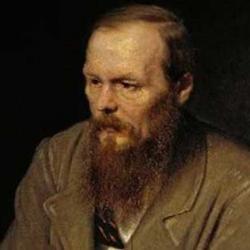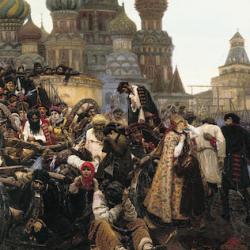I state a thesis: Dostoevsky is a polyphonic hedgehog. The subthesis is that Tolstoy is a monologic fox.
The second part of that comparison comes from Isaiah Berlin’s The Hedgehog and the Fox. Berlin cites the Greek poet Archilochus’s dictum, “A fox knows
many things; a hedgehog knows one big thing,” and says, quite rightly, that Dostoevsky is of the prickly not the smooth-furred species.
But Dostoevsky’s hedgehogginess is of a particular breed, identified by Bakhtin as “polyphonic” (Problems of Dostoevsky’s Poetics). Polyphonic novelists allow many voices to have full play in the text; monologic writers dominate and bully their characters so that they say what the author wants them to say. Tolstoy is Bakhtin’s paradigmatic monologist.
Dostoevsky’s polyphony works at many levels. According to Bakhtin, Dostoevsky invents a new kind of novel,
which is guided by a new poetics, a new set of principles for writing fiction. The poetics ranges across all the features of
Dostoevsky’s novels – the characters, the plots, the ideas, the genre. He characterizes this poetics and this new
sort of novel with the word “polyphony.”
What unifies a novel of Dostoevsky is not plot, not the consciousness of
characters, not the consciousness of the author that incorporates all the
consciousnesses of the characters. The
novels are not even united in a unity of style, since the style of the novels
is internally differentiated. The
unifying key to the novel is the very play of voices, the carnival of different
viewpoints and ideas.
Bakhtin says, “A plurality of independent and unmerged voices and
consciousnesses, a genuine polyphony of fully valid voices is in fact the chief
characteristic of Dostoevsky’s novels.
What unfolds in his works is not a multitude of characters and fates in
a single objective world illuminated by a single authorial consciousness;
rather a plurality of consciousnesses, with equal rights and each with its own
world, combine but are not merged in the unity of the event” (6). The world of Dostoevsky’s fiction is a world
of subjects, not a world of objects. (Nabokov is right that Dostoevsky has a playwright’s sensibilities, but Nabokov means this as a criticism.) The
author’s consciousness is not the overarching consciousness, but only one among
many.
In another effort to define the innovation of Dostoevsky’s
fiction, Bakhtin writes, “The uniqueness of Dostoevsky lies not in the fact
that he monologically proclaimed the value of personality (others had done that
before him); it lies in the fact that he was able, in an objective and artistic
way, to visualize and portray personality as another, as someone else’s
personality, without making it lyrical or merging it with his own voice. . . .
the artistic image of someone else’s personality . . . the image of many unmerged
personalities joined together in the unity of some spiritual event, was fully
realized for the first time in his novels” (12-13).
One of the more dramatic ways this appears is in Dostoevsky’s use
of characters. Bakhtin comments
repeatedly on the “independence” of the characters in Dostoevsky’s novels. But that is not all that Dostoevsky achieves. For Dostoevsky, the hero is not “some manifestation of reality
that possesses fixity and specific socially typical or individually
characteristic traits, nor as a specific profile assembled out of unambiguous
and objective features which, taken together, answer the question Who is he?” Rather,
the hero is “a particular point of view on the world and on oneself” (47). For Dostoevsky, the hero is mainly a
viewpoint on the world; he is interested in how the hero views himself.
Bakhtin contrasts this to Gogol.
In Gogol, we have a specific
type of character, a “poor government clerk” lonely, with a dead-end job and a pathetic excuse for a life. Even when he
was writing in imitation of Gogol, Dostoevsky isn’t interested so much in the
government clerk as such, or as an individual instance of a particular
class. Rather, he is interested in the
self-consciousness of the character.
One way to state this is that Dostoevsky brings “the author and
the narrator, with all their accumulated points of view and with the
descriptions, characterizations, and definitions of the hero provided by them,
into the field of vision of the hero himself, thus transforming the finalized
and integral reality of the hero into the material of the hero’s own
self-consciousness” (49). Bakhtin describes
this as a “small-scale Copernican revolution” in which the authorial definition
of the hero is relativized, made just one more viewpoint on the hero (49).
One effect of this is to create characters that are less than
fully themselves. As Bakhtin says, “A
man never coincides with himself. One
cannot apply to him the formula of identity, A = A. In Dostoevsky’s artistic thinking, the
to him the formula of identity, A = A. In Dostoevsky’s artistic thinking, the
genuine life of the personality takes place at the point of non-coincidence
between a man and himself, at his point of departure beyond the limits of all
that he is as a material being, a being that can be spied on, defined,
predicted apart from his own will, ‘at second hand.’ The genuine life of the personality is made
available only through a dialogic penetration of that personality, during which
it freely and reciprocally reveals itself” (59).
For Dostoevsky, this is not a destruction of the self, but rather
a penetration into the deepest reality of the consciousness of his heroes. They are most themselves not by the
definitions that others can give to them, not by the objective realities of
class, occupation, marital status, physical appearance. They are most themselves in their freedom to
be something beyond all these definitions and external qualities. The man is man is that which “does not submit
to an externalizing secondhand definition,” it is an “internally unfinalizable
something” (58).
Bakhtin overstates his case. Dostoevsky does have a viewpoint and wants to get it
across. He keeps turning people to Jesus. But Bakhtin is profoundly right about how Dostoevsky goes about getting what he has to say across to his readers.










